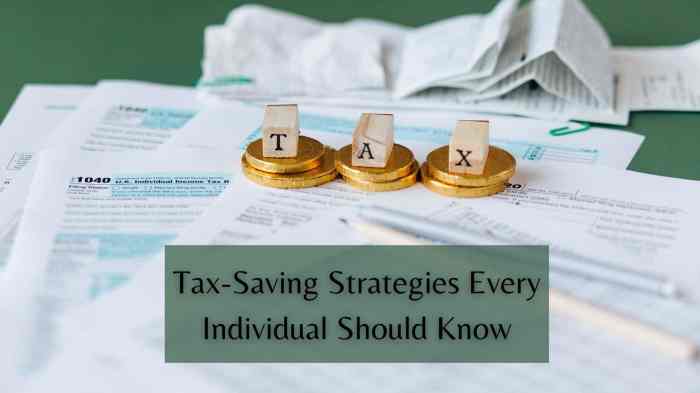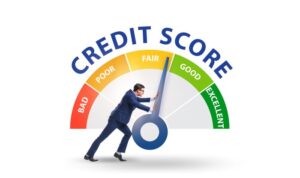Tax saving strategies are not just about saving money; they’re about making the most out of your finances. From individual tactics to business approaches, these strategies can help you navigate the complex world of taxes with ease and efficiency.
Whether you’re looking to reduce your taxable income or capitalize on investment opportunities, understanding and implementing these strategies can lead to significant savings in the long run.
What are Tax Saving Strategies?

Tax saving strategies are methods or techniques used by individuals to minimize the amount of taxes they owe to the government. These strategies help in legally reducing tax liabilities by taking advantage of deductions, credits, and other tax-saving opportunities.
Implementing tax saving strategies is crucial for individuals as it can lead to significant savings on their tax bills. By utilizing these strategies effectively, individuals can keep more of their hard-earned money and allocate it towards their financial goals, such as savings, investments, or other expenses.
Common Tax Saving Strategies
- Contribute to retirement accounts, such as 401(k) or IRA, to lower taxable income.
- Take advantage of tax deductions, such as mortgage interest, charitable donations, or medical expenses.
- Utilize tax credits, like the Earned Income Tax Credit or Child Tax Credit, to reduce tax liability directly.
- Invest in tax-advantaged accounts, such as Health Savings Accounts (HSAs) or 529 college savings plans.
- Plan for capital gains tax by holding investments for the long term or offsetting gains with losses.
Individual Tax Saving Strategies
When it comes to saving on taxes, individuals have various strategies at their disposal to reduce their taxable income and maximize their savings. One key strategy is to take advantage of retirement contributions to lower tax liabilities.
Maximizing Retirement Contributions, Tax saving strategies
- Contributing to a traditional IRA or 401(k) can help lower taxable income for the year.
- Consider contributing the maximum amount allowed by the IRS to fully benefit from tax advantages.
- Individuals over 50 years old may be eligible for catch-up contributions, allowing them to save even more.
Understanding Tax Deductions
- Tax deductions reduce the amount of income that is subject to taxation, lowering the overall tax bill.
- Common deductions include mortgage interest, charitable contributions, and medical expenses.
- By itemizing deductions, individuals can potentially save more on taxes than by taking the standard deduction.
Reducing Taxable Income Legally
- Utilize flexible spending accounts (FSAs) for healthcare and dependent care expenses to lower taxable income.
- Take advantage of tax credits such as the Earned Income Tax Credit (EITC) and Child Tax Credit to reduce taxes owed.
- Invest in tax-advantaged accounts like Health Savings Accounts (HSAs) to save on healthcare expenses.
Business Tax Saving Strategies

When it comes to saving on taxes for your business, there are several strategies you can implement to minimize your tax liabilities and maximize your profits. One key approach is to take advantage of tax credits and deductions that are available to businesses.
Utilizing Tax Credits
Tax credits are a great way for businesses to save money on their tax bills. These credits are dollar-for-dollar reductions in the amount of tax you owe, making them extremely valuable. Some common tax credits for businesses include the Work Opportunity Tax Credit, Research and Development Tax Credit, and the Small Business Health Care Tax Credit. By taking advantage of these credits, you can significantly reduce your tax liability.
Maximizing Deductions
Deductions are another important tool for businesses looking to save on taxes. By deducting eligible expenses from your taxable income, you can lower the amount of income that is subject to taxation. Common deductions for businesses include expenses for equipment, office supplies, travel, and employee wages. Make sure to keep detailed records of these expenses to support your deductions and minimize your tax bill.
Tax Planning Techniques for Small Businesses
For small businesses, tax planning is essential to ensure you are taking advantage of all available tax-saving opportunities. One effective technique is to defer income to future years and accelerate deductions to the current year. This can help you reduce your taxable income in high-profit years and take advantage of deductions when they are most beneficial. Additionally, consider setting up a retirement plan for yourself and your employees to benefit from tax-deferred savings and potential tax credits.
Overall, by implementing these business tax saving strategies, you can optimize your tax situation and keep more of your hard-earned money in your pocket.
Investment-related Tax Saving Strategies
Investment-related tax saving strategies can help individuals and businesses reduce their tax liabilities while building wealth for the future. By strategically investing in tax-efficient vehicles, individuals can take advantage of tax-deferred and tax-free options to minimize the impact of taxes on their investment returns.
Tax-Deferred and Tax-Free Investments
Tax-deferred investments allow investors to postpone paying taxes on their investment gains until a later date, typically when they withdraw the funds. This can help investors grow their wealth more quickly since they are able to reinvest their earnings without the burden of immediate taxes. Examples of tax-deferred investments include 401(k) plans, traditional IRAs, and annuities.
On the other hand, tax-free investments provide investors with the opportunity to earn income or realize gains without having to pay taxes on those earnings. Roth IRAs and Health Savings Accounts (HSAs) are examples of tax-free investment options that can help individuals build tax-free wealth over time.
Minimizing Capital Gains Taxes
One effective strategy to minimize capital gains taxes is to hold investments for the long term. By holding onto investments for more than a year, investors can benefit from lower long-term capital gains tax rates. Additionally, utilizing tax-loss harvesting can help offset capital gains by selling losing investments to counterbalance gains in a given year. This strategy can help reduce the overall tax liability on investment gains.
Overall, understanding how investments can be used as tax-saving tools and strategically utilizing tax-deferred and tax-free investment options can help individuals and businesses optimize their tax savings while building a strong financial future.




